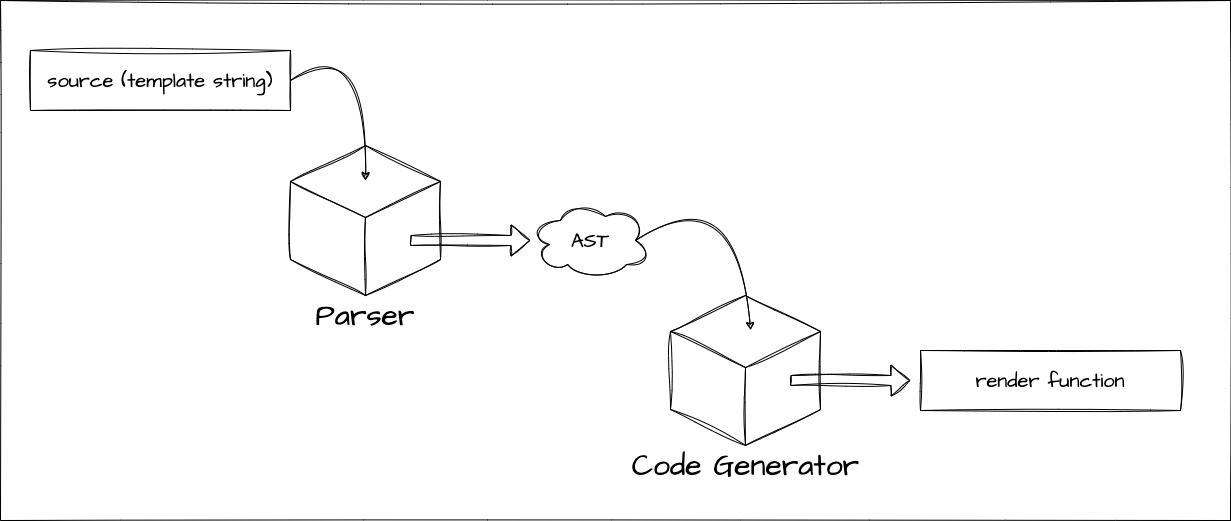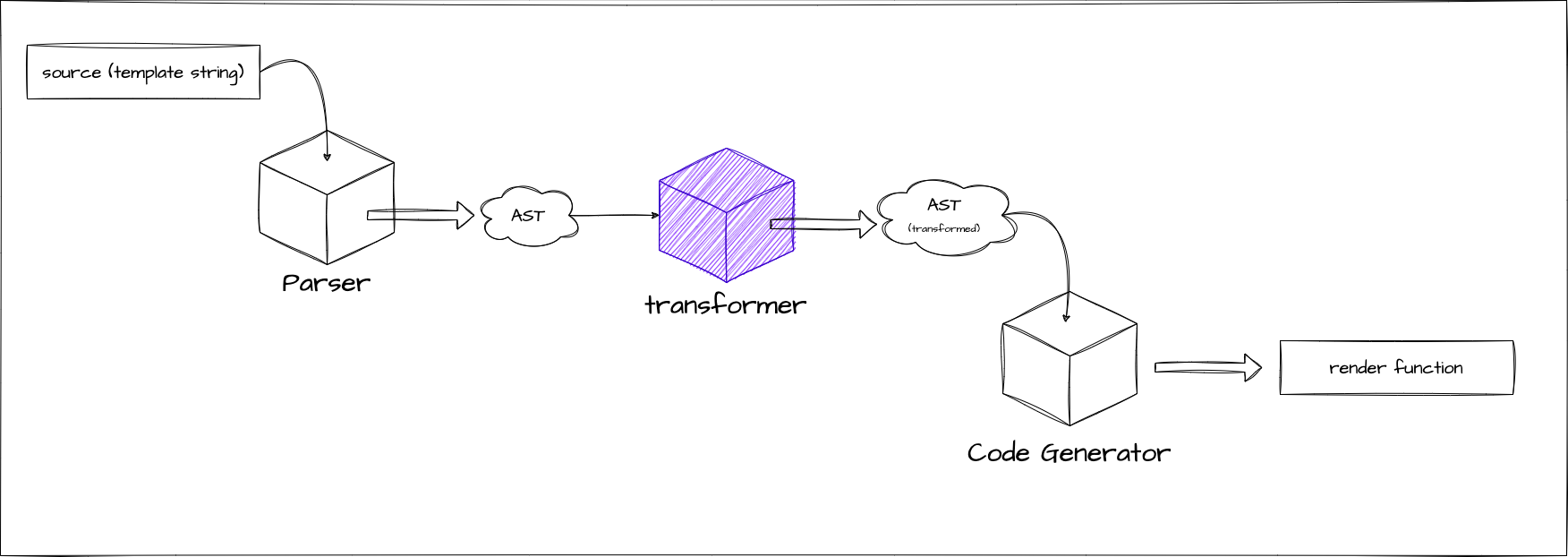轉換器和程式碼生成重構的實現(基礎模板編譯器部門開始)
現有實現的回顧
現在,讓我們從最小示例部門停下的地方開始更認真地實現模板編譯器.距離我們上次處理它已經有一段時間了,所以讓我們回顧一下當前的實現.主要關鍵詞是 Parse,AST 和 Codegen.

export function baseCompile(
template: string,
option: Required<CompilerOptions>,
) {
const ast = baseParse(template.trim())
const code = generate(ast, option)
return code
}實際上,這個配置與原始配置略有不同.讓我們看看原始程式碼.
你能理解嗎...?
export function baseCompile(
template: string,
option: Required<CompilerOptions>,
) {
const ast = baseParse(template.trim())
transform(ast)
const code = generate(ast, option)
return code
}就是這樣.
這次,我們將實現 transform 函式.

什麼是 Transform?
正如你從上面的程式碼中可以想像的那樣,透過解析獲得的 AST 被 transform 函式以某種方式轉換.
這個 VNODE_CALL 和以 JS 開頭的名稱的 AST 程式碼是我們這次要處理的. Vue.js 的模板編譯器分為兩部分:表示解析模板結果的 AST 和表示生成程式碼的 AST. 我們當前的實現只處理前一個 AST.
讓我們考慮將模板 <p>hello</p> 作為輸入的情況.
首先,透過解析生成以下 AST.這與現有實現相同.
interface ElementNode {
tag: string
props: object /** 省略 */
children: (ElementNode | TextNode | InterpolationNode)[]
}
interface TextNode {
content: string
}{
"tag": "p",
"props": {},
"children": [{ "content": "hello" }]
}至於"表示生成程式碼的 AST",讓我們考慮應該生成什麼樣的程式碼. 我認為應該是這樣的:
h('p', {}, ['hello'])這是表示生成的 JavaScript 程式碼的 AST. 換句話說,它是一個表示用於生成應該生成的程式碼的 AST 的物件.
interface VNodeCall {
tag: string
props: PropsExpression
children:
| TemplateChildNode[] // multiple children
| TemplateTextChildNode // single text child
| undefined
}
type PropsExpression = ObjectExpression | CallExpression | ExpressionNode
type TemplateChildNode = ElementNode | InterpolationNode | TextNode{
"tag": "p",
"props": {
"type": "ObjectExpression",
"properties": []
},
"children": { "content": "hello" }
}透過這種方式,表示由 Codegen 生成的程式碼的 AST 被表達. 你可能在這一點上感覺不到分離它們的必要性,但在將來實現指令時會很有用. 透過分離專注於輸入的 AST 和專注於輸出的 AST,我們可以使用稱為 transform 的函式執行從 input AST -> output AST 的轉換.
Codegen 節點
現在我們已經掌握了流程,讓我們確認我們將處理什麼樣的節點(我們想要轉換什麼樣的節點).我將在枚舉它們並提供註釋的同時進行解釋.請參考原始碼獲取準確資訊,因為某些部分被省略了.
export interface SimpleExpressionNode extends Node {
type: NodeTypes.SIMPLE_EXPRESSION
content: string
isStatic: boolean
identifiers?: string[]
}
// 這表示呼叫 h 函式的表達式。
// 它假設類似 `h("p", { class: 'message'}, ["hello"])` 的東西。
export interface VNodeCall extends Node {
type: NodeTypes.VNODE_CALL
tag: string | symbol
props: ObjectExpression | undefined // 注意:在原始碼中實現為 PropsExpression(用於未來擴展)
children:
| TemplateChildNode[] // multiple children
| TemplateTextChildNode
| undefined
}
export type JSChildNode =
| VNodeCall
| ObjectExpression
| ArrayExpression
| ExpressionNode
// 這表示一個 JavaScript 物件。它用於 VNodeCall 的 props 等。
export interface ObjectExpression extends Node {
type: NodeTypes.JS_OBJECT_EXPRESSION
properties: Array<Property>
}
export interface Property extends Node {
type: NodeTypes.JS_PROPERTY
key: ExpressionNode
value: JSChildNode
}
// 這表示一個 JavaScript 陣列。它用於 VNodeCall 的 children 等。
export interface ArrayExpression extends Node {
type: NodeTypes.JS_ARRAY_EXPRESSION
elements: Array<string | Node>
}轉換器設計
在實現轉換器之前,讓我們談談設計.首先,重要的是要注意有兩種類型的轉換器:NodeTransform 和 DirectiveTransform.這些分別用於轉換節點和指令,並採用以下介面.
export type NodeTransform = (
node: RootNode | TemplateChildNode,
context: TransformContext,
) => void | (() => void) | (() => void)[]
// TODO:
// export type DirectiveTransform = (
// dir: DirectiveNode,
// node: ElementNode,
// context: TransformContext,
// ) => DirectiveTransformResult;
export type DirectiveTransform = FunctionDirectiveTransform 將在實現指令時在後面的章節中介紹,所以現在讓我們稱之為 Function. NodeTransform 和 DirectiveTransform 實際上都是函式.你可以將它們視為轉換 AST 的函式. 請注意,NodeTransform 的結果是一個函式.在實現 transform 時,如果你實現它返回一個函式,該函式將在該節點的轉換之後執行(它被稱為 onExit 過程). 你想在節點的 transform 之後執行的任何處理都應該在這裡描述.我將在稍後描述稱為 traverseNode 的函式時解釋這一點. 介面的解釋主要如上所述.
作為更具體的實現,有用於轉換元素的 transformElement 和用於轉換表達式的 transformExpression 等. 至於 DirectiveTransform 的實現,每個指令都有實現. 這些實現在 compiler-core/src/transforms 中實現.具體的轉換過程在這裡實現.
圖像 ↓
接下來,關於上下文,TransformContext 保存在這些轉換期間使用的資訊和函式. 將來會添加更多,但現在這就足夠了.
export interface TransformContext extends Required<TransformOptions> {
currentNode: RootNode | TemplateChildNode | null
parent: ParentNode | null
childIndex: number
}轉換器的實現
現在讓我們在實踐中看看 transform 函式.首先,讓我們從獨立於每個轉換過程內容的框架的一般解釋開始.
結構非常簡單,只需生成上下文並使用 traverseNode 函式遍歷節點. 這個 traverseNode 函式是轉換的主要實現.
export function transform(root: RootNode, options: TransformOptions) {
const context = createTransformContext(root, options)
traverseNode(root, context)
}在 traverseNode 中,基本上,它只是將保存在上下文中的 nodeTransforms(轉換節點的函式集合)應用於節點. 對於那些有子節點的,子節點也透過 traverseNode 傳遞. 在介面解釋期間提到的 onExit 的實現也在這裡.
export function traverseNode(
node: RootNode | TemplateChildNode,
context: TransformContext,
) {
context.currentNode = node
const { nodeTransforms } = context
const exitFns = [] // 轉換後要執行的操作
for (let i = 0; i < nodeTransforms.length; i++) {
const onExit = nodeTransforms[i](node, context)
// 註冊轉換後要執行的操作
if (onExit) {
if (isArray(onExit)) {
exitFns.push(...onExit)
} else {
exitFns.push(onExit)
}
}
if (!context.currentNode) {
return
} else {
node = context.currentNode
}
}
switch (node.type) {
case NodeTypes.INTERPOLATION:
break
case NodeTypes.ELEMENT:
case NodeTypes.ROOT:
traverseChildren(node, context)
break
}
context.currentNode = node
// 執行轉換後要執行的操作
let i = exitFns.length
while (i--) {
exitFns[i]() // 可以假設轉換已完成而執行的操作
}
}
export function traverseChildren(
parent: ParentNode,
context: TransformContext,
) {
for (let i = 0; i < parent.children.length; i++) {
const child = parent.children[i]
if (isString(child)) continue
context.parent = parent
context.childIndex = i
traverseNode(child, context)
}
}接下來,讓我們談談具體的轉換過程.作為示例,讓我們實現 transformElement.
在 transformElement 中,我們主要將類型為 NodeTypes.ELEMENT 的節點轉換為 VNodeCall.
export interface ElementNode extends Node {
type: NodeTypes.ELEMENT
tag: string
props: Array<AttributeNode | DirectiveNode>
children: TemplateChildNode[]
isSelfClosing: boolean
codegenNode: VNodeCall | SimpleExpressionNode | undefined
}
// ↓↓↓↓↓↓ 轉換 ↓↓↓↓↓↓ //
export interface VNodeCall extends Node {
type: NodeTypes.VNODE_CALL
tag: string | symbol
props: PropsExpression | undefined
children:
| TemplateChildNode[] // multiple children
| TemplateTextChildNode
| undefined
}這是一個簡單的物件到物件的轉換,所以我認為不會很困難.讓我們嘗試透過閱讀原始碼來實現它. 我將貼上我這次假設的程式碼以防萬一.(指令支援將在另一章中完成.)
export const transformElement: NodeTransform = (node, context) => {
return function postTransformElement() {
node = context.currentNode!
if (node.type !== NodeTypes.ELEMENT) return
const { tag, props } = node
const vnodeTag = `"${tag}"`
let vnodeProps: VNodeCall['props']
let vnodeChildren: VNodeCall['children']
// props
if (props.length > 0) {
const propsBuildResult = buildProps(node)
vnodeProps = propsBuildResult.props
}
// children
if (node.children.length > 0) {
if (node.children.length === 1) {
const child = node.children[0]
const type = child.type
const hasDynamicTextChild = type === NodeTypes.INTERPOLATION
if (hasDynamicTextChild || type === NodeTypes.TEXT) {
vnodeChildren = child as TemplateTextChildNode
} else {
vnodeChildren = node.children
}
} else {
vnodeChildren = node.children
}
}
node.codegenNode = createVNodeCall(vnodeTag, vnodeProps, vnodeChildren)
}
}
export function buildProps(node: ElementNode): {
props: PropsExpression | undefined
directives: DirectiveNode[]
} {
const { props } = node
let properties: ObjectExpression['properties'] = []
const runtimeDirectives: DirectiveNode[] = []
for (let i = 0; i < props.length; i++) {
const prop = props[i]
if (prop.type === NodeTypes.ATTRIBUTE) {
const { name, value } = prop
properties.push(
createObjectProperty(
createSimpleExpression(name, true),
createSimpleExpression(value ? value.content : '', true),
),
)
} else {
// directives
// TODO:
}
}
let propsExpression: PropsExpression | undefined = undefined
if (properties.length) {
propsExpression = createObjectExpression(properties)
}
return {
props: propsExpression,
directives: runtimeDirectives,
}
}基於轉換後的 AST 的程式碼生成
由於我們為 Codegen 轉換了 AST,我們也需要支援 Codegen. 對於進入 Codegen 的 AST,假設 VNodeClass(以及它們擁有的節點)編寫程式碼就足夠了. 期望的最終字串表示與以前相同.
現有的 Codegen 實現非常簡單,所以讓我們在這裡使它更正式一些(因為它相當硬編碼). 讓我們也創建一個 Codegen 特定的上下文並將生成的程式碼推送到其中. 此外,讓我們在上下文中實現一些輔助函式(如縮排).
export interface CodegenContext {
source: string
code: string
indentLevel: number
line: 1
column: 1
offset: 0
push(code: string, node?: CodegenNode): void
indent(): void
deindent(withoutNewLine?: boolean): void
newline(): void
}我將在這裡省略實現細節,但我只是為每個角色分離了函式,實現方法沒有重大變化. 由於我還沒有能夠支援指令,由於在該區域刪除了臨時實現,有些部分不工作,但 如果程式碼大致按以下方式工作,就可以了!
import { createApp, defineComponent, ref } from 'chibivue'
const App = defineComponent({
setup() {
const count = ref(0)
return { count }
},
template: `
<div class="container">
<p> Hello World! </p>
<p> Count: {{ count }} </p>
</div>
`,
})
const app = createApp(App)
app.mount('#app')到此為止的原始碼: chibivue (GitHub)
